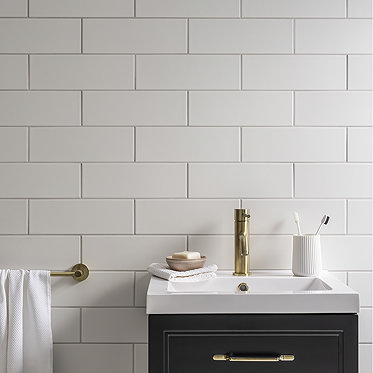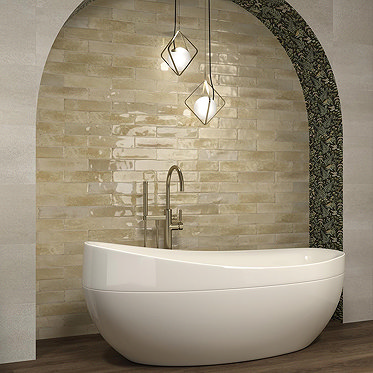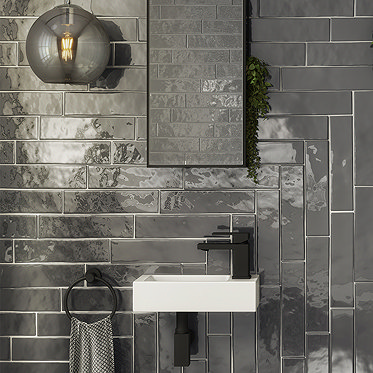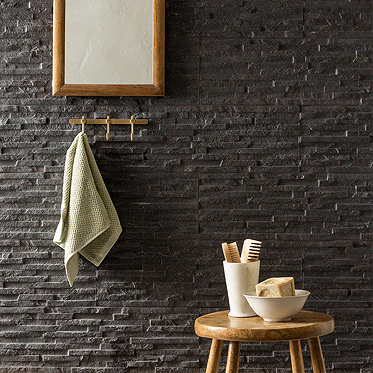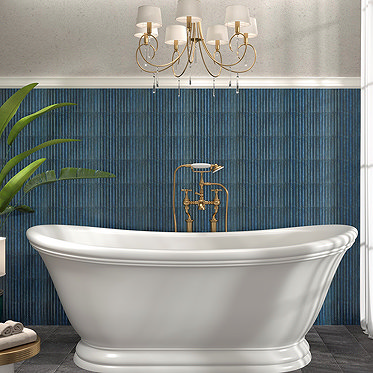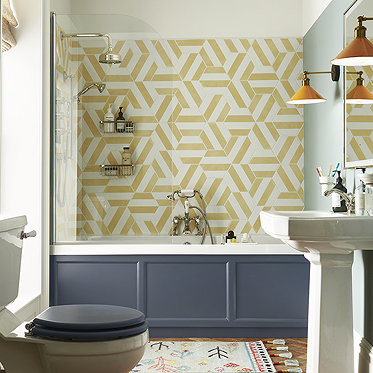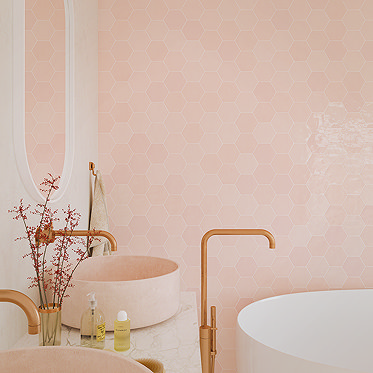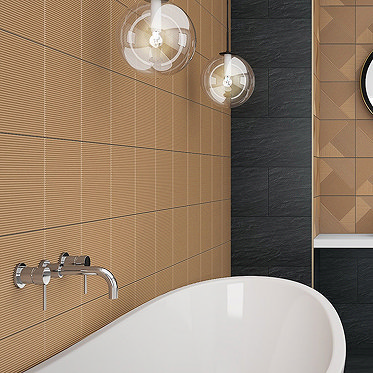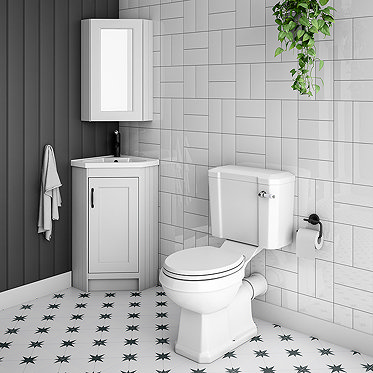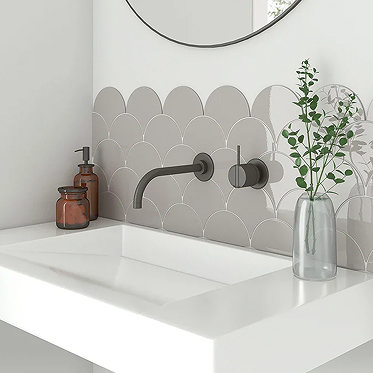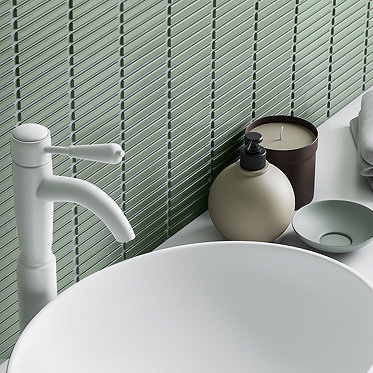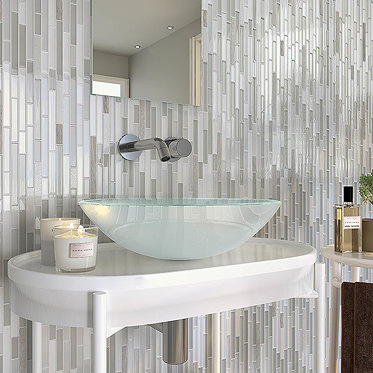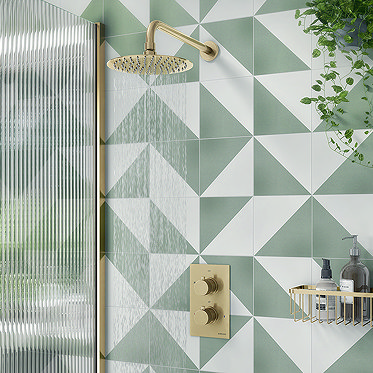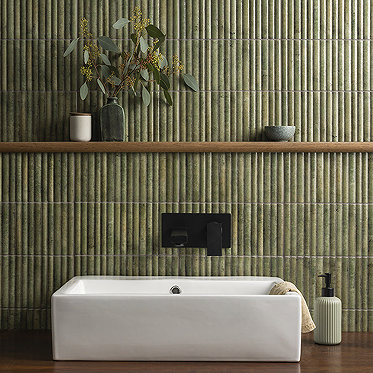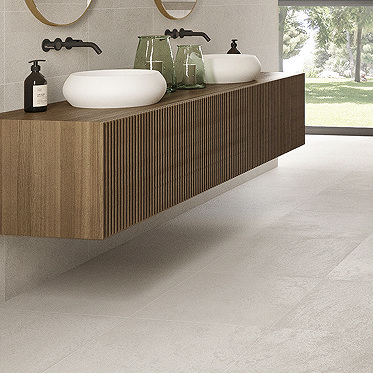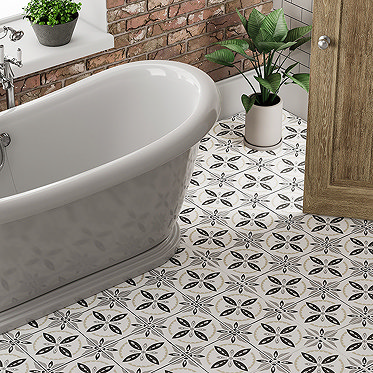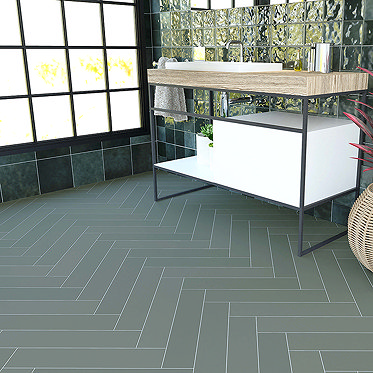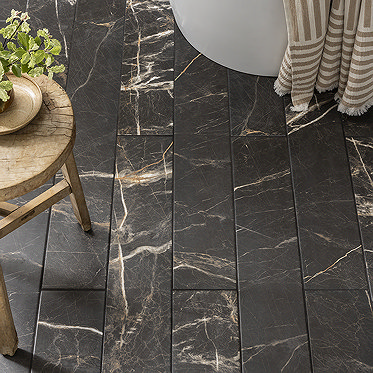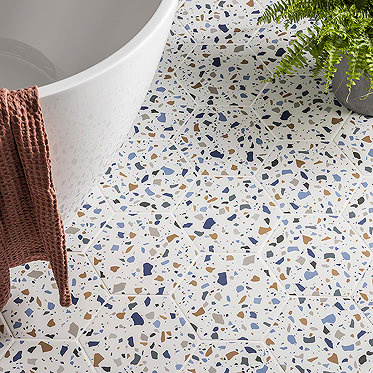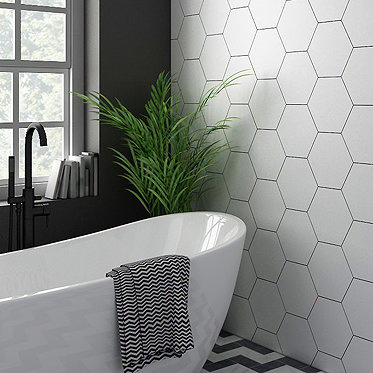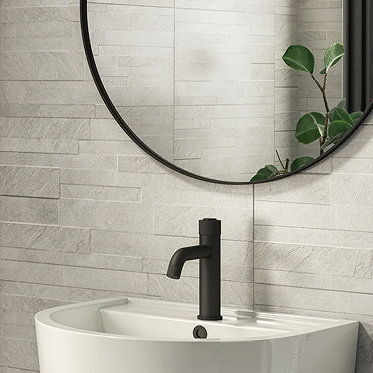UP TO 60% OFF SPRING SALE!
Free Delivery on Orders Over £499**
Bathroom Tiles Buying Guide
Bathroom Tiles Buying Guide
Choosing Wall and Floor Tiles for Your Bathroom

Welcome to the world of bathroom tiles — those not-so-humble surfaces that can define your bathroom’s style, practicality, and overall ambience. Whether you’re upgrading a family bathroom, designing a sleek en-suite, or optimising a compact cloakroom, this comprehensive bathroom tiles buying guide will help you choose the perfect wall and floor tiles.
We’ll walk you through materials, colours, sizes, slip resistance, and cost ranges, ensuring your new tiles not only look amazing but also stand the test of time. Ready to transform your space? Let’s get tiling!
Click Below to Jump to a Section
For First-Time Tile Buyers
- Space & Positioning for Bathroom Tiles
- Tile Size & Slip Resistance
- Tile Materials & Colours
- Bathroom Wall Tiles
- Bathroom Floor Tiles
- Bathroom Tile Cost Range
Savvy Shopper: Technical & DIY Tips
For First-Time Bathroom Tile Buyers
A Quick Overview
If this is your first time purchasing bathroom tiles, start by assessing the following:
- Moisture Levels: Will the tiles be in a shower area, splash zone, or just around the sink?
- Wall vs. Floor Requirements: Floor tiles must be thicker and often slip-resistant, whereas wall tiles can be lighter.
- Style & Focal Points: Decide if you want a bold feature wall, a patterned floor, or a neutral background.
- Measurements: Calculate your room dimensions (length × width for floors; width × height for walls). Subtract doors and windows, then add 5–10% extra for breakages and cuts.
Space & Positioning for Bathroom Tiles
Think carefully about where and how to place your tiles:
- Shower & Bath Areas: Ensure proper waterproofing behind tiles and choose impervious or vitreous tiles that stand up to constant moisture.
- Around the Basin: Splashback tiling (often 2–4 rows above the sink) guards against water damage.
- Feature Walls: A bold accent tile behind the vanity or tub can become a stunning focal point.
- Full vs. Partial Tiling: Tiling the entire wall (floor to ceiling) creates a seamless look; partial tiling can reduce costs and avoid a “boxed in” feel in very small spaces.
Pro Tip: Planning tile layout is key—account for any niches, mirrors, or fixtures to avoid awkward cuts.
Tile Size & Slip Resistance
Tile Size
When it comes to tile size, large tiles feature fewer grout lines, which can visually enlarge a small bathroom, but they may require more intricate cutting in tight or irregular spaces. Small or mosaic tiles, on the other hand, are perfect for splashbacks, decorative accents, or shower floors, as their additional grout lines can aid slip resistance—though the installation process may be more time-consuming.
Tile Slip Resistance
Slip resistance simply refers to how well a tile’s surface helps prevent slips and falls, particularly in wet or high-traffic areas. It’s often measured using an R-rating (ranging from R9 to R13, with R13 being the most slip-resistant) and a PEI (Porcelain Enamel Institute) rating, which determines the tile’s wear resistance. PEI 0 tiles should be used on walls only, PEI 2–4 tiles work well for most residential floors, and PEI 5 tiles can handle heavy commercial foot traffic.
Bathroom Tile Materials & Colours
Popular Bathroom Tile Materials
Ceramic
- Suitable for: Affordable and easy-to-cut tiles that work well on walls or in light-traffic floor areas.
- Not Suitable for: High-traffic floors or wet areas without proper PEI and slip ratings, as ceramic is less durable than porcelain.
Porcelain
- Suitable for: Dense, highly water-resistant tiles ideal for floors and high-moisture areas like showers.
- Not Suitable for: Projects where heavy tiles are impractical, as porcelain is heavier, pricier, and requires more robust subfloors or wall support.
Glass
- Suitable for: Reflective surfaces that brighten small bathrooms and are easy to clean, often used for mosaics or feature walls.
- Not Suitable for: Installations where adhesive visibility could be an issue, as glass requires skilled installation and is typically more expensive.
Natural Stone (Marble, Slate, Travertine)
- Suitable for: Adding a luxurious look and feel to bathrooms, with unique textures and appearances.
- Not Suitable for: Areas requiring low maintenance, as natural stone needs sealing and can be prone to scratching or staining. Often more expensive.
Stone-Effect, Metal-Effect or Wood-Effect Tiles
- Suitable for: Replicating the look of natural stone or wood with less maintenance and cost.
- Not Suitable for: Buyers seeking the most realistic finish, as lower-quality versions may lack authenticity.
Popular Bathroom Tile Colours & Aesthetics
Neutrals
Bold Statements
Playful & Unique Tones
Mix & Match
Combine feature tiles (e.g., mosaic, patterned) with simpler ones to avoid an overpowering aesthetic. For instance, pair a bold pink or green accent wall with neutral white or grey floor tiles.
Bathroom Tile Finishes: Gloss vs. Matt
- Glossy Tiles: Reflect light, which is great for small bathrooms needing an illusion of more space. They do, however, show watermarks more easily.
- Matt Tiles: Hide smudges and water spots better, providing a subtler, modern look—particularly chic in black, brown, or grey.
Tip: Use colour swatches or sample tiles in your actual bathroom lighting to see how the hue changes during different times of day.
Bathroom Wall Tiles
Wall tiles protect against moisture, simplify cleaning, and can transform plain walls into artful statements.
Types of Bathroom Wall Tiles
Bathroom Floor Tiles
Floor tiles must withstand foot traffic, moisture, potential slips, and the weight of fixtures (baths, cabinets).
Types of Bathroom Floor Tiles
Key Floor Tile Considerations
- Slip Resistance: Look for R10 or higher in bathrooms, especially if kids or older adults use the space.
- Underfloor Heating: Porcelain and ceramic conduct heat well; check the tile’s compatibility with your heating system.
- Maintenance: Smooth tiles are easier to mop; textured surfaces may trap more dirt but provide extra grip.
- Pattern & Shape: Herringbone, hexagonal, or large-format squares can add strong visual impact.
Wall & Floor Tiles
If versatility is what you’re after, wall and floor tiles are the multitaskers of the bathroom world. These tiles blur the boundaries between walls and floors, creating seamless, cohesive designs that exude style and sophistication.
Wall & Floor Tiles
Bathroom Tile Styles & Shapes
Victorian Bathroom Tiles
Victorian tiles are a nod to timeless elegance, featuring intricate patterns, rich colours like navy and burgundy, and heritage designs. Ideal for checkerboard floors or detailed feature walls, they pair beautifully with brass taps and clawfoot baths.
Modern Bathroom Tiles
Modern tiles focus on sleek, minimalist aesthetics with neutral tones and clean lines. Large formats and matte finishes create a seamless, contemporary look that’s effortlessly chic.
Rustic Bathroom Tiles
Rustic tiles bring the warmth of nature indoors with stone-effect finishes, terracotta tones, and handcrafted textures. Perfect for creating a cosy, countryside feel, they complement wood accents and vintage-style fixtures.
Country Bathroom Tiles
Soft pastels, floral patterns, and stone finishes define country tiles. They add charm and warmth to any space, working seamlessly with neutral palettes and shaker-style furniture.
Square Bathroom Tiles
Simple yet stylish, square tiles are a versatile choice. From classic mosaics to bold statement colours, they suit both walls and floors, effortlessly adapting to traditional or modern designs.
Rectangular Bathroom Tiles
Rectangular tiles are a timeless staple, offering versatility for all styles. Use metro tiles for vintage charm or large formats for a bold, modern statement.
Bathroom Tile Cost Range
Tiles come in a variety of price points to suit different budgets, from bargain mosaic sheets to luxury porcelain and designer effects. Here’s a quick breakdown:
£0–£10 per Sheet/Tile
- Budget-Friendly Mosaic Sheets: Brands like Stonehouse Studio and Chatsworth offer mini Kit-Kat, herringbone, hexagon, octagon mosaic sheets in various colours/finishes.
- Perfect for Accents: Ideal for feature walls, shower niches, or decorative borders. Despite the low cost, many come with unique designs and on-trend hues.
- In Stock & Well-Reviewed: Typically in stock with good reviews—great for adding style on a tight budget.
£10–£20 per m² / Sheet
- Popular Metro & Flat Tiles: Includes Victoria Metro and Metro Flat wall tiles in an array of colours—white, grey, cream, pink, mint, etc.
- Rustic & Zellige-Style: Handcrafted looks (Vernon Rustic, Beauvais, Delphine) for vintage charm.
- Mosaic & Stone Looks: Glass-and-stone mosaics (Alaska, Turin) and stone-effect options broaden design possibilities.
- DIY-Friendly: Peel-and-stick backsplashes (Avignon, Catalan) appear here—ideal for quick updates.
£20–£30 per m²
- Expanded Style Choices: More stone effect, wood effect, concrete effect, and rustic brick tiles (Esta, Denton, Lathom) often suit both walls and floors.
- Larger Formats & Designer Touches: Look for 300×600mm, 315×615mm, hexagon, chevron, etc. Typically porcelain or premium ceramic.
- Durability & Versatility: Ideal for mid-range projects seeking robust finishes, slip resistance, and underfloor-heating compatibility.
£30–£40 per m²
- Premium & Decorative Patterns: Encaustic, Art Deco, geometric (Kingsbridge, Buxton, Stonehouse Studio) plus fluted or split-face textures.
- High-End Stone & Wood Effects: Larger tiles (e.g., 600×600mm) in marble, terrazzo, or rustic wood finishes give a designer edge.
- Bold Colours & Rectified Edges: Expect vibrant hues (pink, teal, red) and sleeker grout lines—ideal for statement walls or floors.
£40–£50 per m²
- Designer & Specialty Tiles: Brands like RAK Ceramics and Villeroy & Boch offer advanced porcelain finishes, outdoor-rated tiles, or unique shapes (fish scale, fluted).
- Artisanal & Trend-Forward: Scallop/fish-scale wall tiles (Asheville range), polished marble effects, bold geometric patterns (Chequers, Buxton, Helsinki).
- Long-Lasting Quality: Rectified edges, robust materials for wet zones or high-traffic floors. Perfect for a premium aesthetic without breaking into top-tier pricing.
£50+ per m²
- Luxury & Large-Format: Expect oversized tiles (e.g., 600×1200mm, 1000×1000mm, or even 1200×2800mm) from brands like Villeroy & Boch, RAK Ceramics, or Liona by Luvanto.
- Innovative Designs: Advanced marble, onyx, or metal oxide effects, plus unique wood or stone patterns. High-end vinyls and splashbacks also feature here.
- Bespoke & Show-Stopping: Ideal for luxury renovations, outdoor porcelain terraces, or designer statement walls/floors—often with finance options if you’re investing in a truly standout finish.
Disclaimer: Prices and stock levels are subject to change. Always verify current prices and availability before purchasing.
Savvy Shopper: Technical & DIY Tips For Bathroom Tiles
1. Water Absorption & Porosity
- Choose vitreous or impervious tiles (low water absorption) for wet areas.
- Avoid non-/semi-vitreous tiles in high-moisture zones.
2. Rectified vs. Non-Rectified
- Rectified: Mechanically cut edges for minimal grout lines and a sleek look.
- Non-Rectified: Slight edge variations can introduce a more traditional feel.
3. Sealing Requirements
- Natural Stone: Must be sealed before and after grouting.
- Porcelain/Ceramic: Typically no sealing needed.
4. Underfloor Heating
Check that your chosen tile is compatible. Porcelain and ceramic usually excel at conducting heat.
DIY & Preparation Advice For Bathroom Tiles
To ensure a successful tiling project, start by preparing your surfaces. Walls or floors must be stable, level, and waterproofed, particularly around showers and baths. If you are tiling over wood, use a backer board for additional support, and on cement, consider using leveling compounds for a smooth base.
Next, measure and plan your project carefully. Calculate the area by multiplying the length by the width for floors or the width by the height for walls, and subtract the dimensions of doors and windows. Always add 5–10% extra tiles to account for breakages or future repairs, and plan fixture placements to avoid awkward cuts.
When choosing adhesives and grout, ensure the adhesive is suitable for the tile type and the specific environment (e.g., rapid-set adhesives for porcelain floors or standard-set adhesives for walls). Select grout colours thoughtfully; dark or coloured grout hides stains and can accent patterns, while white or matching grout creates a seamless appearance. Use silicone sealant around corners or movement joints for added flexibility.
For installation, professionals often recommend tiling from the top to the bottom of walls to hide any discrepancies at the floor line. On floors, start from the center if you want a symmetrical layout or from the most visible wall for the best aesthetic outcome.
Safety is essential, so wear gloves, goggles, knee pads, and a dust mask during installation. Basic tools like a tile cutter, spacers, a notched trowel, a spirit level, a marker, and tape are necessary for the job.
If you are tiling over old tiles, make sure the existing tiles are stable and fully adhered. Be aware of potential issues such as trapped moisture or hidden cracks, and ideally, remove old tiles for a reliable substrate.
Finally, evaluate your confidence level. If you are unsure of your DIY skills or the project involves large or complex layouts (such as herringbone or mosaics), consider hiring a professional to achieve a polished, watertight result.
Top Bathroom Tile Brands
When selecting bathroom tiles, reputable brands ensure quality and style. Popular choices include:
- Liona by Luvanto: Stylish, modern designs with a focus on durability and easy installation.
- RAK Ceramics: High-quality porcelain and ceramic tiles, known for innovative designs and robust performance.
- Stonehouse Studio: Specialises in stone-effect finishes, bringing natural textures to your bathroom without the heavy maintenance.
- Victorian Plumbing: Offers a broad selection of on-trend and classic designs, well-priced for different budgets.
- Villeroy & Boch: Synonymous with European craftsmanship; premium porcelain collections in timeless, elegant styles.
Brands Disclaimer: Availability may vary by retailer. Always check stock levels and request samples for color accuracy before making a final decision.
Frequently Asked Bathroom Tile Questions
What are the best tiles for bathroom walls and floors?
The best tiles for bathroom walls and floors depend on your needs:
- Wall Tiles: Ceramic or porcelain tiles are ideal for water resistance and easy maintenance. Glossy metro tiles or marble-effect tiles add elegance.
- Floor Tiles: Porcelain, natural stone, or slip-resistant tiles with R10+ ratings ensure durability and safety in wet areas.
How do I calculate how many tiles I need for my bathroom?
To calculate tiles for your bathroom:
- Measure the area (length × width for floors; width × height for walls).
- Subtract the space for doors and windows.
- Add 5–10% extra for cuts and breakages.
Are large tiles better for small bathrooms?
Yes, large tiles can make small bathrooms appear more spacious. Fewer grout lines create a seamless look, enhancing the illusion of space. However, intricate cuts may be needed in tight areas, so plan layouts carefully.
What tile slip rating is best for bathroom floors?
For bathroom floors, choose tiles with an R10 or higher slip rating to ensure safety in wet areas. This is especially important for households with children or older adults.
Final Thoughts
Tiles are an excellent long-term investment for your bathroom, offering durability, easy maintenance, and endless design possibilities. Whether you opt for classic metro subway tiles, a statement-making hexagonal pattern, or the luxurious look of marble-effect porcelain, the key is to balance style, budget, and practicality. Don’t be afraid to request samples, create a mood board, and experiment with layout patterns—your bathroom should reflect your unique taste while standing up to daily use.
Ready to tile? Explore various materials and finishes, plan carefully, and if DIY feels daunting, enlist a qualified tiler for a watertight, professional finish. With the right tiles, your bathroom will transform into a serene, spa-like retreat that you’ll love for years to come.
Need More Bathroom Tips?
- Visit our blog for design inspiration and how-to guides.
- Share this guide with friends and family to help them find their perfect bathroom tiles, too!
